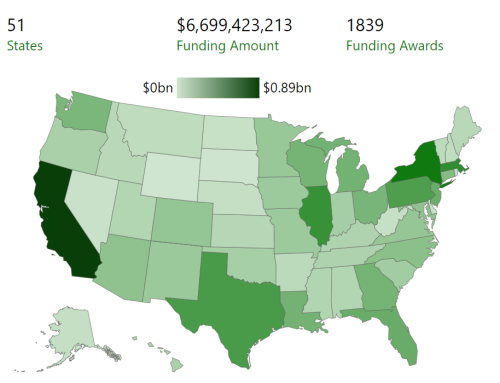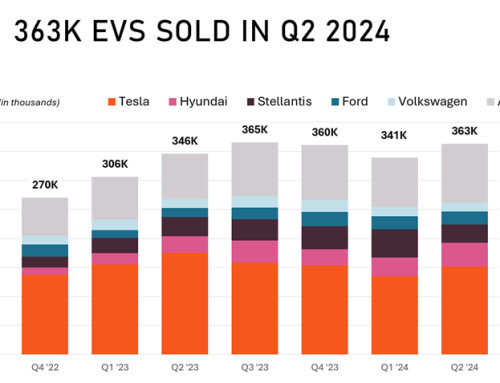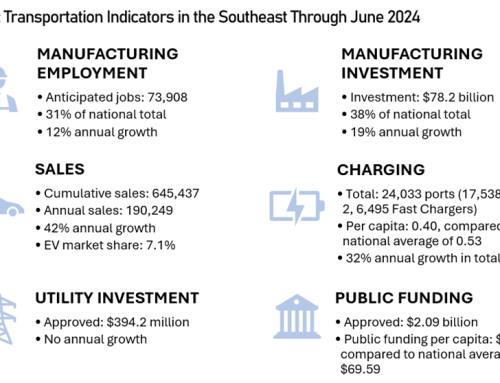
Atlas Founder Nick Nigro speaks with Donna Dickson from Ford Motor Company and Marco McCottry from Uber on Day One of the Forth Roadmap Conference.
This digest was written by Atlas Policy Analyst Kelsey Blongewicz.
Last week, my colleagues and I joined the transportation electrification community in Detroit for two conferences. The EV Infrastructure National Conference was hosted by the National Association of State Energy Offices (NASEO), the American Association of State Highway and Transportation Offices (AASHTO), and the Joint Office of Energy and Transportation. Largely geared towards state and federal agencies, meeting topics included progress on the National Electric Vehicle Infrastructure (NEVI) program and other infrastructure programs, updates on the latest federal guidance, and solutions for national EV infrastructure deployment. Here are some highlights from those sessions:
-
States are eager to achieve fully built out status and begin the next phase of NEVI – bringing charging off the highways and into the communities. This phase will give them more flexibility in site design, power levels, and location, serving an even greater number of EV drivers and encouraging increased EV adoption.
-
There are challenges from both state and industry perspectives in standing up new EV charging procurement processes and contracts. Considering total cost of ownership of charging equipment, requiring a full-service maintenance agreement, and incorporating post-contract flexibility were all topics of discussion.
-
There are lessons learned from early rounds of NEVI solicitations, awards, and contracting, which means that subsequent rounds are going more quickly. States are sharing this experience amongst themselves and charging companies are bringing best practices from early award cycles.
-
State agencies have been collaborating in Working Groups over the past year and will be sharing recommendations with federal agencies and industry surrounding topics related to EVs and Grid Integration, Equity, Cybersecurity of EV Charging, and Data and Reporting.
Although everyone – states, federal agencies, charging networks, utilities – has encountered challenges in working towards a national EV charging network, a lot of progress has been made. Conversations throughout the meeting were constructive, collaborative, and enthusiastic. There was a willingness to collaborate, ask for help, and learn from each other. Mutually assured construction was the name of the game at this conference!
Next up, starting on Wednesday, we attended the Forth Roadmap Conference. One of the marquee annual transportation electrification conferences on the calendar, Roadmap brought new and veteran attendees from industry, automakers, government, and nonprofits from across the country.
Normally located in Portland, Oregon, this was the first year that Roadmap was hosted in Detroit and the conference embraced its new home and celebrated being in the automotive capital of the universe. As we heard during keynote sessions from the Lt. Governor of Michigan, Garlin Gilchrist II, and Carla Walker-Miller of Walker-Miller Energy Services, Detroit is back! Historically a pioneer in the automotive industry, Detroit is now on the forefront of transportation electrification as well.
Also on the main stage, Atlas founder Nick Nigro hosted a fireside chat with executives from Ford and Uber to discuss their companies’ electrification goals and challenges. Outside of keynotes, sessions were divided into four tracks – vehicles, charging, impact, and cutting edge. In the vehicles category, Atlas’ James Di Filippo joined a panel discussing used EVs and previewed some forthcoming research into the state of the used EV market in New York State.
Other takeaways from the conference included:
-
Equity is top of mind for many. In her keynote, Carla Walker-Miller advocated that mobility requires equity and diverse, empowered voices, saying “do not speak for people you do not speak to.” Similarly, in Justice40, tribal electrification and workforce development sessions, there were calls to be inclusive, and consider the different starting point for different communities – that is, electrification may be more difficult in places with less reliable electricity.
-
The passenger EV market is preparing to go mainstream in the next few years as automakers push to introduce EVs at prices competitive with everyday gasoline vehicles. The expo floor showcased GM’s competitively priced Chevy Equinox EV, a lower price EV model that can travel 300 miles on a charge.
-
As progress in the transportation electrification movement picks up speed, there are areas that will require particular attention: educating customers on the benefits of EVs not just that they are electric versions of what they know already, expanding medium and heavy-duty electrification beyond return to base operations, improving charging user experience, or upcoming federal funding opportunities across numerous federal agencies.
Throughout the conference, there was an air of excitement – excitement to be meeting partners and collaborators in person, excitement to be in Detroit, and excitement to build a just and sustainable electric future across all modes of transportation.
If you missed out on Forth this year, save the date for next year – we’ll be back in Detroit in October 2025!


